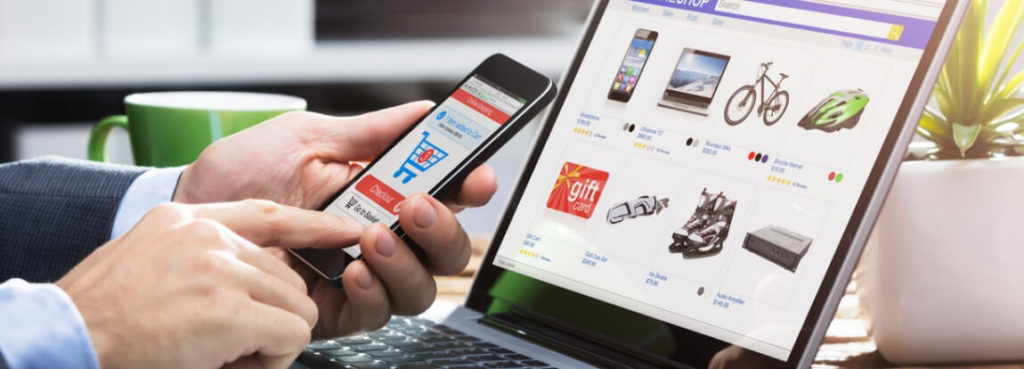Suppose someone gets to your product page and falls in love with your product. They need it. They have to have it right now. So they go to your where to buy page and follow the link to Amazon, Target, or Walmart—whoever their preferred retailer is.
But instead of taking them to your product page on that retailer’s website, you drop them off at the homepage. Amazon.com. Target.com. Walmart.com. And now they have to hunt to find your product page.
We call it “main paging.” And it’s one of the most common ecommerce errors manufacturers make.
Here’s why it’s so problematic.
It disrupts the path to purchase
The whole point of highlighting your online retail partners and sending potential customers to them is to streamline the path to purchase.
You know Amazon Prime members are always going to choose Amazon for the free two-day shipping. You know some people want to purchase from Walmart or Target so they can buy online and pick-up in store (BOPIS), and have your product immediately. And numerous other online retailers offer rewards programs, special credit cards, and other incentives that are tough to compete with. Plus, it’s way more convenient to buy from a retailer you’ve bought from before because you don’t have to create a new account and enter credit card information all over again.
Since you know some consumers want to buy from specific retailers, you’re helping them get there sooner by linking directly to the retailer they want. But when you link to the main store page, it derails the customer journey. It creates one more step between your customer and your product.
And there’s a lot that can happen as a result of that one extra step. It might make consumers think your product is no longer available at that retailer. It might kill their momentum, and be enough to make them feel like they don’t need your product anymore. And it’s always going to create frustration—because they weren’t looking for Walmart.com. They were looking for your product on Walmart.com, and you didn’t take them there.
And if they’re still willing to make the effort and type your product name in the search bar, there are other risks, too.
It exposes potential customers to competitors
When someone clicks to go to a retailer from your where to buy link, the odds are pretty good that they’re either ready to purchase, or at least making that final decision. But if you send them to a retailer’s main page, all of a sudden they have to type your product name, brand, and/or product category into the search bar—and your product isn’t all they’re going to see there.
They’re going to see your product listed alongside several other products that are most related to their search query. AKA your main competitors. Some of these people are determined to buy your product. Maybe they’re already loyal to your brand, or they’ve been convinced by your marketing. But others simply haven’t looked into the competition yet. Maybe you were the only brand in your space that they’d heard of. Or they assumed you had the lowest price or best ratings.
Those search results are dangerous. Because remember: you sent these people here. You know you have the best product available, but you want to diminish the variables that might lead someone to choose an inferior competitor. Maybe your competitor is running a sale that day, or they have better ratings with more reviews, more appealing features, or more colors and variations.
You’re asking them to make a choice between you and your competitors—when they were about to choose you. It’s like putting a pop-up over your buy button that says, “Are you sure you want to do this?”
You could’ve controlled the entire path to purchase by sending people from your website directly to a product page, but instead, you created an opportunity for your potential customers to encounter your biggest competitors.
It wastes your marketing efforts
You spend time and energy driving people to your product pages. Ads, social media posts, email sends, blog posts, and other promotional efforts aren’t free. So when you make basic ecommerce mistakes, they don’t just cost you sales—they waste your marketing dollars.
If you want to get the greatest return on investment in your marketing, you need to make the path to purchase as direct as possible. Main paging punches a hole in your marketing funnel, and a lot of shoppers are going to dribble out of it. Some of those shoppers will simply not act on their intent to purchase. Others will buy from your competitors—and when that happens, it’s like you’re paying money to send people to your competition.
Show people where to buy your product
It’s not good enough to send potential customers to a retailer’s homepage. They expect a clear, direct path from your website to your product page on their favorite retailer’s site. If you don’t give them that, you’re not really showing them where to buy your product. You’re sending them back to the beginning of the path—only this time they’re annoyed with you, and your competitors are about as likely to close the sale as you are.
For more ecommerce-related tips, subscribe to our podcast, PriceSpider Ecommerce Connected—available via Apple Podcasts or Android.

